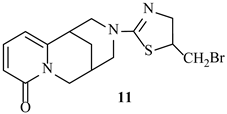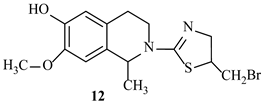Abstract
The interaction results of 1,2-dibromo-3-isothiocyanatopropane with some pyrazoles as well as cytisine and salsoline alkaloids were presented in this paper. It was shown that the reaction resulted in one one-step and rather mild method for the preparation of the corresponding 1,3-thiazoline bromomethyl derivatives. The yield of this reaction was affected by the presence of a base and an order in which reagents were added. Molecular docking of the synthesized 1,3-thiazoline derivatives for putative antibacterial activity was carried out using the penicillin-binding target protein (PBP4) of the bacteria E. coli “Homo sapiens” and S. aureus “Homo sapiens” as an example. Molecular docking demonstrated that the compounds had insignificant binding energies at the level of selected reference drugs (Cephalotin and Chloramphenicol). The presence of natural alkaloids in the structure of thiazoline derivatives somewhat increased the affinity of these substrates for target proteins selected.
1. Introduction
The number of publications related to the synthesis and investigation of the biological activity of various thiazoles and their derivatives has recently increased. Thiazoles are five-membered heterocyclic compounds containing nitrogen and sulfur atoms. The thiazole itself exhibits high aromaticity. Hydrogenated thiazoles, namely 1,3-thiazoline and 1,3-thiazolidine, do not have aromatic properties. Hantzsch synthesis based on the reaction between α-haloketones (or α-haloaldehydes) with thioamides is one of the well-known methods for thiazole derivatives preparation [1,2,3,4]. To obtain dihydrothiazoles (thiazoline, thiazolidine) thiazole reduction methods are not applied, but intramolecular cyclizations of the corresponding thioamides are mainly put to use.
The thiazole cycle is widespread in natural compounds such as vitamin B1 (Thiamine), Penicillin, thiazole alkaloid, e.g., bacillamide A, B, C and neobacillamide A [5,6,7].
In addition, the thiazole scaffold is part of many drugs with high pharmacological activity, such as Meloxicam (non-steroidal anti-inflammatory drug) [8], Pramipexole (antidepressant) [9], Norsulfazolum (antimicrobial agent) [10], Tiazofurin (anticancer drug) [11] (Figure 1).
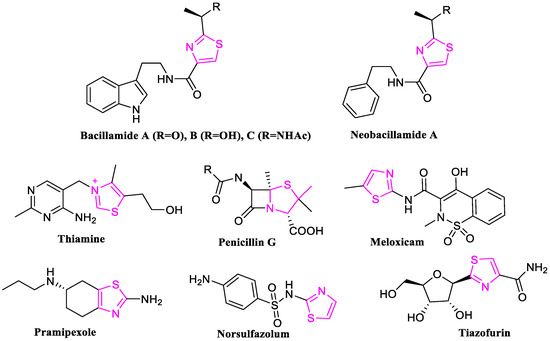
Figure 1.
Natural and synthetic physiologically active compounds containing a thiazole cycle.
To date, there has been accumulated a huge amount of literature material on a wide range of biological activities of many other synthetic thiazole derivatives, such as antibacterial, antiviral, antifungal, anticancer, antiulcer, anti-inflammatory, antihypertensive, herbicidal, anthelmintic, antiparasitic, insecticidal ones [12,13,14,15,16,17,18,19,20,21,22].
Considerable interest in the synthesis of various thiazole derivatives is also associated with the discovery of their semiconductor properties, which determine their possible application in organic electronics as efficient solar cells and organic semiconductors [23,24].
Reduced forms of thiazoles, namely thiazolines have also received particular attention as preferred scaffolds with various pharmacological activities such as anti-inflammatory [25,26], antimicrobial [27,28,29,30], antidiabetic [31,32,33], anticancer [34,35,36] and antioxidant ones [37,38].
The combination of other physiologically active groups in the heterocyclic compounds structure can lead not only to an increase in the main therapeutic effect, but also to the emergence of new types of biological activity [39]. It is also known that many nitrogen-containing heterocyclic compounds are used in pharmaceutical practice as broad-spectrum drugs [40,41,42]. Pyrazole derivatives occupy a special place among them due to the greater preparative availability. In recent years, this has been caused by the increasing use of its derivatives as drugs, dyes, luminescent and fluorescent substances [43]. Pyrazole derivatives have proven to be effective pharmaceuticals with a variety of therapeutic activities, such as Mepirizole and Fezolamine (Figure 2), showing anti-inflammatory and antidepressant activities [44,45]. And, of course, among pyrazole derivatives, there are found substituted antipyrines (1-phenyl-2,3-dimethyl-5-pyrazolone) synthesized more than half a century ago, namely Aminophenazone and Metamizole, which exhibit antipyretic and analgesic effects [46,47] (Figure 2).

Figure 2.
Pharmaceutical preparations containing a pyrazole heterocycle.
In works [48,49] the antidiabetic activity of new 1-substituted derivatives of 3,5-dimethylpyrazole was also demonstrated.
Quite often, halogenation methods and the introduction of sulfur-containing fragments are used as a chemical modification of many heterocyclic compounds. The presence of halogen substituents in the heterocycles structure results in the therapeutic effect amplification due to an increase in the lipophilicity of the resulting substances and facilitates their passage through biomembranes [50].
2. Results and Discussion
Most thiourea and thioureide derivatives have not only valuable pharmacological properties and are used as antiepileptic drugs [51], antidiabetic [52], anti-cancer [53], anti-tuberculosis [54] and other therapeutically active substances [55], but they are also initial synthons in the synthesis of many sulfur-containing heterocycles [56,57,58,59,60].
Isothiocyanate method [61] is one of the preparatively convenient methods allowing introducing thiourea or thioureide fragments into many aromatic and heterocyclic amines, including physiologically active alkaloids. It has been shown by us earlier on numerous examples [62,63,64,65].
The corresponding thioureas cyclization is used for the synthesis of many thiazole derivatives. Methods for the preparation of thiazoline heterocyclic derivatives from the corresponding allyl-containing thioureas under the action of various reagents, namely solutions of hydrogen halides and halogens, were described in the literature [66,67]. At the same time, compounds based on the pyrazole fragment, containing thiourea, thioamide or thiazole groups, are practically not described in the literature and represented by single examples [68].
Since interaction of isothiocyanates with amines was known to be the main method for obtaining thioureas, there was chosen 4-bromo-3,5-dimethylpyrazole 2 obtained by bromination of a preparatively available 3,5-dimethylpyrazole 1 to synthesize the corresponding thiourea derivative [69].
Further, on its basis, the interaction with allyl isothiocyanate was carried out (Scheme 1).

Scheme 1.
Synthesis of 4-bromo-3,5-dimethylpyrazole 2 and its allylthiourea derivative.
It was found that the reaction of 4-bromo-3,5-dimethylpyrazole 2 with the selected isothiocyanate, in contrast to simple and more basic alicyclic and aromatic amines, took longer time and required heating the reaction mixture to 50 °C. The yield of allylthiourea 3 was 71%. Analysis of the 1H NMR spectrum of compound 3 showed that there were intense narrow singlets of almost equivalent methyl protons of the pyrazole ring in the region of 2.08 and 2.15 ppm. The terminal allyl protons CH2 = of the thiourea fragment appeared as a system of multiplets from ddd and broadened dd in the region of 5.10–5.35 ppm with SSCC 2J = 17.0 Hz, 3J = 10.2 Hz. 4J = 1.5 Hz. The methine proton at the CH = double bond appeared as a complex multiplet (ddt) centered at 5.91 ppm. (Figure S1. Supplementary Material).
In the mass spectrum of N-allyl-(4-bromo-3,5-dimethyl-1H-pyrazole)-1-carbothioamide 3 with m/z and relative intensity Jrel (%), in addition to two peaks of the molecular ion 273, 275 [M]+ (10.5%), there were fragments of the molecule decomposition along the N-C(S) bond with the basic 4-bromo-2,3-dimethylpyrazole fragment: 176, 174 (100%), as well as other fragments: 242, 240 (70%), 95 (39%), 41 (62%), 39 (90%) (Figure S7. Supporting Information), indicating the ease of the C–N bond cleavage between the pyrazole and thioamide fragments under an electron impact action.
In the works [70,71,72] it was shown that the corresponding N-allylthiocarbamides (4a–c) synthesized by the interaction of cytisine (a), salsoline (b), and anabasine (c) alkaloids with allylisothiocyanate in a solution of concentrated hydrochloric acid, when heated in a sealed ampoule for 5–6 h, underwent intramolecular cyclization to 1,3-thiazoline derivatives 5a–c (Scheme 2).

Scheme 2.
Synthesis of allylthiourea derivatives of alkaloids and cyclization.
The following transformations in order to obtain new physiologically active compounds which combined the basic pyrazole ring and the sulfur-containing thiazole heterocycle in their structure were carried out. The ampoule cyclization of N-allyl-(4-bromo-3,5-dimethyl-1H-pyrazole)-1-carbothioamide 3 under the action of a hydrochloric acid solution was carried out by analogy with the procedures for N-allylthiocarbamides 4a–c cyclization. However, when processing the reaction mixture, the expected corresponding cyclic 1,3-thiazoline 6 was not isolated, but the initial 4-bromo-3,5-dimethylpyrazole 2, which was probably formed as a result of conventional hydrolysis at the C–N bond between the pyrazole ring and thioamide fragment (Scheme 3).
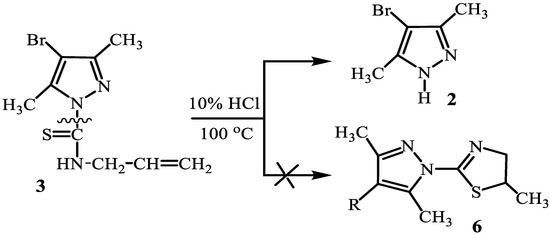
Scheme 3.
Acid hydrolysis of N-allyl-(4-bromo-3,5-dimethyl-1H-pyrazole)-1-carbothioamide 3.
In order to obtain new 1,3-thiazoline pyrazole derivatives of type 6, another alternative method for their preparation was used. The method was based on the use of a highly reactive isothiocyanate reagent, namely 2,3-dibromopropylisothiocyanate (7). The latter was used for a one-step synthesis of thiazoline derivatives via intramolecular heterocyclization of intermediate dibromo-substituted thioureas [73,74]. 2,3-Dibromopropylisothiocyanate (7) was synthesized by allylisothiocyanate bromination in chloroform medium according to the procedure [75].
When carrying out the reaction of 3,5-dimethylpyrazole 1 and 4-bromo-3,5-dimethylpyrazole 2 with 2,3-dibromopropylisothiocyanate 7, it was found that intramolecular heterocyclization of the intermediate 2,3-dibromopropyl-substituted thioureas occurred at Scheme 4:
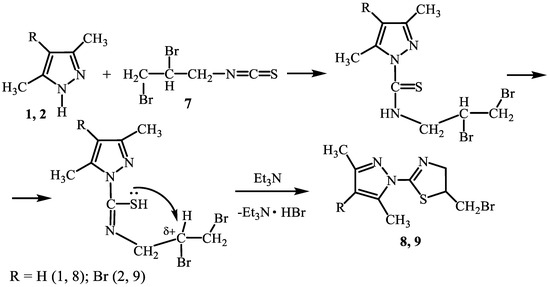
Scheme 4.
Mechanism of interaction of 2,3-dibromopropylisothiocyanate 7 with substituted pyrazole.
It was found that the reaction course and the target products yield directly depended on the reagent’s addition order, the use of a solvent indifferent to the starting 2,3-dibromopropylisothiocyanate 7, and a hydrogen bromide acceptor. So, for example, when adding a solution of 2,3-dibromopropylisothiocyanate 7 to an alcohol (or benzene) solution of 3,5-dimethylpyrazole 1, about 50% of the original 3,5-dimethylpyrazole 1 remained unreacted at the reaction end, bound in the form of hydrobromide. It was possible to isolate the final reaction product in the form of a base in a high yield (96%) by changing the reagents addition order, using indifferent benzene and an excess of triethylamine as an acceptor of hydrogen bromide obtained during cyclization. 4-Bromo-3,5-dimethylpyrazole 2 resulted in the formation of the corresponding product 9 in a lower yield (65%).
The obtained bromomethyl 1,3-thiazoline derivatives of 3,5-dimethylpyrazole 8 and 4-bromo-3,5-dimethylpyrazole 9 are stable, well-crystallized white crystalline substances, soluble in many organic solvents and in hydrocarbons (when heated).
The composition, structure, and identity of the synthesized compounds 8, 9 were confirmed by elemental analysis, IR, 1H NMR spectroscopy and mass spectrometry.
When analyzing the 1H and 13C NMR spectra of compounds 8, 9 (Figures S2 and S3 Supporting Information) recorded in DMSO solution, it was found that a mixture of rotational isomers with axial and equatorial arrangement of the bromomethyl radical relative to the 1,3 planes of thiazoline ring was detected in the solution, which had been fixed by the corresponding duplicate peaks.
X-ray diffraction investigation was carried out in order to establish the spatial structure of the 5-(bromomethyl)-2-(3,5-dimethyl-1H-pyrazol-1-yl)-4,5-dihydrothiazole molecule 8. The molecule 8 general view is shown in Figure 3.
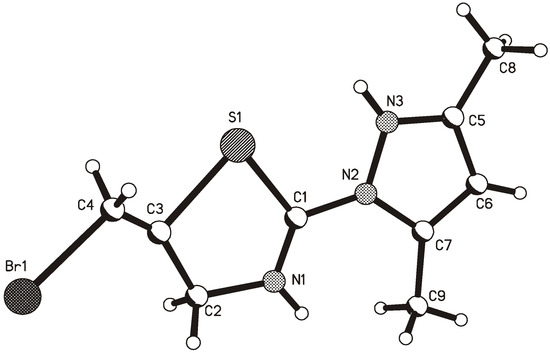
Figure 3.
ORTEP representations of the compound 8 molecular structure.
Analysis of structure 8 (CCDC 723563) showed that bond lengths and bond angles were close to usual [76]. The thiazoline ring adopted a strongly flattened sofa conformation (ΔC8s = 1 Å). In our opinion, this was due to the strong ring tension, as well as the influence of a heavier bromine atom, which resulted in shortening the C4-C3 bond (0.997 Å) and elongating the C3-S1(2.049 Å) bond (Table S1. Supporting Information). Such anomalies are possible due to several factors, namely a molecule fragment disorder, possibly also during the cocrystallization of two isomers, or the crystal turned out to be an intergrowth (twin). The pyrazole cycle is planar with an accuracy of ±0.007 Å. The methyl groups are oriented equatorially and lie in the pyrazole ring plane.
Thiazole derivatives that combine physiologically active alkaloids in their structure, namely cytisine and salsoline [77,78] which can potentially exhibit high pharmacological activity, are of particular interest. The reaction positive results prompted us to check the reproducibility of this reaction on the example of some biologically active alkaloids (cytisine a, salsoline b), as well as methylamino-substituted pyrazole (1,3,5-trimethyl-1H-pyrazol-4-yl)methanamine 10, synthesized according to the method (Scheme 5).
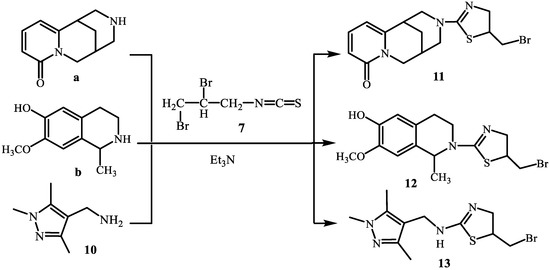
Scheme 5.
Interaction reaction of alkaloids (a), (b), amine 10 with 2,3-dibromopropylisothiocyanate 7.
As a result of the reactions performed, there were isolated in good yields (72–83%) the corresponding bromomethyl 1,3-thiazoline derivatives 11–13 based on physiologically active alkaloids, namely cytisine and salsoline, as well as methylamino-substituted pyrazole 10. The resulting compounds 8, 9, 11–13 can be initial synthons for subsequent alkylation reactions and the synthesis of new biologically active compounds.
Structures of the synthesized compounds 11–13 were confirmed by elemental analysis, IR, 1H NMR spectroscopy and mass spectrometry.
When analyzing the 1H and 13C NMR spectra of compounds 11–13 (Figures S4 and S5. Supporting Information) recorded in a DMSO solution, as well as for compounds 8, 9, it was established that a mixture of rotational isomers with axial and equatorial arrangement of the bromomethyl radical relative to the plane of the 1,3-thiazoline ring was found in the solution.
The mass spectra analysis of compounds 11–13 showed that the molecules were not sufficiently stable under the electron impact action, since the spectra contained almost no peaks of the molecular ion, or they were present, but with a low relative intensity. All mass spectra showed intense fragments with eliminated hydrobromide [M-HBr] (Figures S9 and S10. Supporting Information).
Molecular docking
According to numerous published data on the antibacterial activity of many thiazole derivatives, the molecular docking method was used to evaluate the possible putative antibacterial activity of the synthesized derivatives 8, 9, 11–13. Penicillin binding protein 4 (PBP4) E. coli “Homo sapiens” (PDB: 2EXB) [79] and Penicillin binding protein 4 (PBP4) S. aureus “Homo sapiens” (pdb: 3HUN) [80] were chosen as target proteins.
Three-dimensional (3D) structures were obtained from the RCSB Protein Data Bank [81], while the ligand molecules were plotted with ChemBio3D Ultra 14.0. The protein structure was prepared for docking by removing the water molecule, the native ligand and adding polar hydrogen atoms, and converted to pdbqt format using the AutoDock MGL software package [82]. The docking process was carried out using AutoDock Vina [83]. Active site grid coordinates (X = 87.0, Y = −5.0 и Z = 45.0; the size 20 × 20 × 20 Å) were applied for (PBP4) E. coli “Homo sapiens” (PDB: 2EXB) [79] and active site grid coordinates (X = −22.0, Y = 4.0 и Z = 1.0; the size 20 × 20 × 20 Å) were applied for (PBP4) S. aureus “Homo sapiens” (pdb: 3HUN) [80]. Ligand interactions at binding sites were interpreted using the Discovery Studio Visualizer [84].
In addition, the structures of the standard antibiotics Cephalotin and Chloramphenicol were used as comparators due to their proven antibacterial activity [85,86].
According to the molecular docking results, compound 8 had a weak binding energy of −5.2 kcal/mol with Penicillin binding protein 4 (PBP4) E. coli “Homo sapiens”, which was due to the formation of one hydrogen bond between the nitrogen atom of the thiazoline ring with the amino acid ASN 308 and two carbon-hydrogen bonds between the carbon atom of the thiazoline ring with amino acid SER 303 and the nitrogen atom of the thiazoline ring with amino acid ASN 308 (Figure 4).
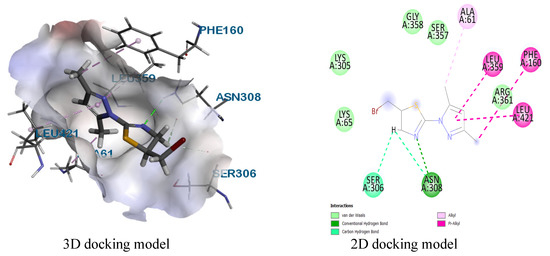
Figure 4.
Complex between 8 and Penicillin binding protein 4 E. coli “Homo sapiens” (2EXB).
Compound 8 had a weak binding energy of −5.6 kcal/mol with Penicillin binding protein 4 (PBP4) S. aureus “Homo sapiens”, which was associated with the formation of one carbon-hydrogen bond between the nitrogen atom of the thiazoline ring with the amino acid SER 116 and two hydrogen bonds between the nitrogen atoms of the thiazoline ring and the pyrazole ring with the amino acid SER 75 (Figure 5).
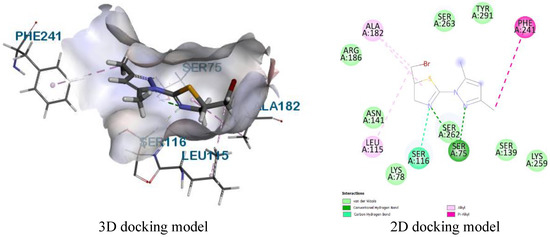
Figure 5.
Complex between 8 and Penicillin binding protein 4 S. aureus “Homo sapiens” (3HUN).
Derivative 11 showed a higher binding energy of −6.6 kcal/mol with Penicillin binding protein 4 (PBP4) E. coli “Homo sapiens” due to one carbon-hydrogen bond of the carbon atom (C-4) of the piperidine core of cytisine (Figure 6).
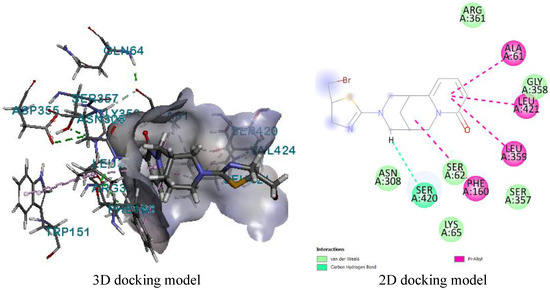
Figure 6.
Complex between 11 and Penicillin binding protein 4 E. coli “Homo sapiens” (2EXB).
Structure 12 had a higher binding energy of −7.5 kcal/mol with Penicillin binding protein 4 (PBP4) S. aureus “Homo sapiens” due to one carbon-hydrogen bond between the oxygen of the hydroxyl group with the amino acid ASP 264 and three hydrogen bonds between the oxygen of the hydroxyl group and methoxy groups of salsoline with amino acids ARG 186 and GLU 183 as well as between the nitrogen atom of the thiazoline ring with amino acid SER 75 (Figure 7).
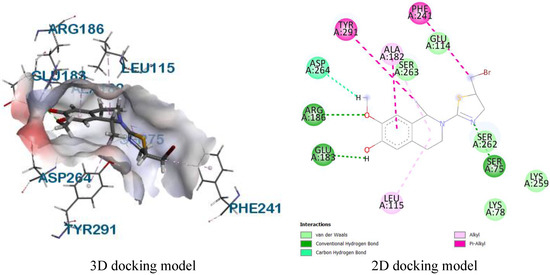
Figure 7.
Complex between 12 and Penicillin binding protein 4 S. aureus “Homo sapiens” (3HUN).
Analysis of the interactions of 2EXB and 3HUN protein complexes with ligands 8, 9, 11–13 showed that all the studied derivatives formed sufficiently strong complexes with the target receptor protein (Table 1).

Table 1.
Binding affinity (kcal/mol) of 1,3-thiazoline derivatives with active sites of penicillin binding proteins 4 (PBP4) E. coli “Homo sapiens” (PDB: 2EXB) and S. Aureus (PDB: 3HUN).
The number of intermolecular hydrogen bonds, the binding energy of stable ligand-receptor complexes (2EXB and 3HUN) and the number of the nearest amino acid residues were determined for the synthesized compounds 8, 9, 11–13 (Table 2).

Table 2.
Basic amino acid interactions and H-bonds.
3. Experimental
FTIR spectra were obtained with an Agilent Cary 630 spectrophotometer in a thin sample layer on a crystal attachment. 1H and 13C NMR spectra were recorded on a Bruker DRX400 (400 and 100 MHz, respectively) and Bruker AVANCE 500 (500 and 125 MHz, respectively) instruments using DMSO-d6, the internal standard was TMS or residual solvent signals (2.49 and 39.9 ppm 1H and for 13C nuclei in DMSO-d6).
Chromato-mass spectrometric studies were carried out on a Trace GC Ultra chromatograph with a DSQ II mass-selective detector in the electron ionization mode (70 eV) on a Thermo TR-5 MS quartz capillary column, 15 m long, 0.25 mm inner diameter, with a film thickness of the stationary phase of 0.25 μm. Splitless input mode was used. Carrier gas discharge was 20 mL/min. The velocity of the carrier gas (helium) was 1 mL/min. Evaporator temperature was 200 °C, transition chamber temperature was 200 °C, ion source temperature was 200 °C. The temperature of the column thermostat was changed according to the program, namely from 15 (5 min delay) to 220 °C at a rate of 20 °C per minute, to 290° at a rate of 15° per minute. The total analysis time was 30 min. The volume of the injected sample was 1 μL. Chromatograms were recorded in TIC mode. The range of mass scanning was 30–450 amu.
Melting points were determined using a Stuart SMP10 hot bench. Monitoring of the reaction course and the purity of the products was carried out by TLC on Sorbfil plates and visualized using iodine vapor or UV light.
X-ray diffraction experiment. Cell parameters and intensities of 1480 independent reflections were measured on a Bruker APEX-II CCD diffractometer, MoKα-radiation, graphite monochromator, θ/2θ-scan, 2θ ≤ 60°. There were rhombic crystals, a = 5.5149(5), b = 18.4636(7), c = 20.7277(11) Å, V = 2110.6(2)Å3, dcalc = 1.600g/cm3, Z = 8 (C9H13N3SBr), space group Pbca. The structure was elucidated by the direct method and refined by full-matrix least squares in the anisotropic approximation for non-hydrogen atoms. The H atoms were calculated geometrically and planted according to the “rider” type. The calculations used 958 reflections with I > 2σ(I). Final divergence factors were R = 0.082 and WR2 = 0.227. The structure was solved and refined using the programs “SHELXS-97” and “SHELXL-97”. The structure geometrical parameters were deposited with the CSDC (CCDC 723563).
Experimental Procedures
N-allyl-4-bromo-3,5-dimethyl-1H-pyrazole-1-carbothioamide 3. A solution of 1.75 g (0.01 mol) of 4-bromo-3,5-dimethylpyrazole in 10 mL of 2-propanol was added dropwise to a solution of 1 g (0.01 mol) of allylisothiocyanate in 10 mL of 2-propanol at a temperature of 50 °C. The solution was stirred for about 6 h. After the solvent distillation and recrystallization of the residue from hexane, there was obtained 1.95 g (71%) of a white crystalline substance with m.p. 50–52 °C. (2-PrOH). 1H NMR (500 MHz, DMSO-d6, δ, ppm, J/Hz): 2.08 (s, 3H, CH3); 2.15 (s, 3H, CH3), 4.22–4.37 (m, 2H, NH-CH2-CH=), 5.17 (ddd, 1H, J = 16.72, 10.3, 1.5, =C-Ha), 5.29 (br. dd, 1H, J = 17.01, 10.2, =C-Hb), 5.85–5.97 (ddt, 1H, J = 17.62, 10.25, 5.10, -CH=CHaHb), 12.58 (br. s, 1H, NH-CH2). 13C NMR (101 MHz, DMSO-d6) δ ppm 12.1, 12.7, 46.4, 98.0, 115.2, 135.1, 142.3, 148.2, 160.5. MS (EI) m/z (Irel, %): 275 [M]+ (10), [M]+ 273 (10), 242 (69), 240 (71), 176 (100), 175 (78), 174 (99), 95 (39), 42 (46), 41 (62), 39 (89). Anal. calcd. for C9H12BrN3S: C, 39.78; H, 4.66; N, 15.81; found: C, 39.43; H, 4.41; N, 15.33.
5-(bromomethyl)-2-(3,5-dimethyl-1H-pyrazol-1-yl)-4,5-dihydrothiazole 8 (General method). A solution of 0.96 g (10 mmol) of 3,5-dimethylpyrazole 1 in 7 mL of benzene was added within 30 min to a solution of 2.60 g (10 mmol) of 2,3-dibromopropylisothiocyanate 7 and 1.01 g (20 mmol) of triethylamine in 10 mL of abs. benzene with vigorous stirring and a temperature of 20 °C. The solution was heated for about 3 h at a temperature of 40 °C. The precipitate of triethylamine hydrobromide was filtered off, washed with benzene. The benzene solution was evaporated to yield 2.63 g (96%) of a white crystalline substance with m.p. 101.5–102.5 °C (hexane-benzene). 1H NMR (500 MHz, DMSO-d6, δ, ppm, J/Hz): 2.15 (s, 3H, CH3); 2.47 (s, 3H, CH3), 3.65 (dd, 1 H, BrCH2a, J = 9.7, 9.7 Hz), 3.72 (dd, 1 H, BrCH2b, J = 9.9, 9.8 Hz), 4.25–4.30 (m, 3H, =N-CH2, S-CH), 6.15 (s, 1H, H-4 pyrazole). 13C NMR (125 MHz, DMSO-d6) δ ppm 13.1, 13.5, 37.0, 50.1, 65.2, 110.0, 142.1, 150.3, 156.1. Anal. calcd. for C9H12BrN3S: C, 39.81; H, 4.76; N, 15.52; found: C, 39.43; H, 4.41; N, 15.33.
2-(4-bromo-3,5-dimethyl-1H-pyrazol-1-yl)-5-(bromomethyl)-4,5-dihydrothiazole 9 was obtained by analogy with 8 from 2.60 g (10 mmol) of 2,3-dibromopropylisothiocyanate 7, 1.01 g (20 mmol) of triethylamine and 1.75 g (10 mmol) of 4-bromo-3,5-dimethylpyrazole 2. The yield was 2.29 g (65%); white crystals, m.p. was 106–107 °C (2-PrOH/hexane, 2:1). 1H NMR (400 MHz, DMSO-d6, δ, ppm, J/Hz): 2.16 (s, 3H, H3); 2.49 (s, 3H, CH3), 3.64–3.72 (m, 2 H, BrCH2), 4.28–4.33 (m, 3H, =N-CH2, S-CH). 13C NMR (101 MHz, DMSO-d6) δ ppm 12.1, 12.8, 37.0, 50.5, 65.2, 99.6, 139.9, 148.9, 156.1. MS (EI) m/z (Irel, %): 355 [M]+ (5), [M]+ 353 (10), 351 [M]+ (5), 276 (5), 275 (12), 274 (95), 272 (100), 187 (15), 175 (78), 173 (90). Anal. calcd. for C9H11Br2N3S: C, 30.62; H, 3.14; N, 11.90; found: C, 30.94; H, 3.43; N, 12.27.
3-(5-(bromomethyl)-4,5-dihydrothiazol-2-yl)-1,2,3,4,5,6-hexahydro-8H-1,5-methanopyrido [1,2-a][1,5]diazocin-8-one 11 was obtained by analogy with 8 from 2.60 g (10 mmol) of 2,3-dibromopropylisothiocyanate 7, 2.02 g (20 mmol) of triethylamine and 1.90 g (10 mmol) of cytisine a. The yield was 2.72 g (74%); white crystals, m.p. was 166–168 °C (2-PrOH/hexane 1:1). 1H NMR (400 MHz, DMSO-d6, δ, ppm, J/Hz): 1.97 (br. s, 2H, H-8), 2.56 (br. s, 1H, H-5), 3.16 (br. s, 1H, H-1), 3.24 (br. d, 2H, H-4a), 3.4 (d, 1 H, J = 5.0 Hz, H-2a), 3.42 (dd, 2H, BrCH2, J= 9.8, 6.2 Hz), 3.45 (m, 1H, H-4e) 3.70–3.80 (m, 2H, =N-CH2), 3.82–3.86 (m, 1H, H-2e), 3.98 (d, 1H, H-6a, J = 15.1 Hz), 4.02 (d, 1H, H-6e, J = 9.6 Hz), 4.08–4.14 (m, 1H, S-CH), 6.23 (d, 1H, H-11, J11,10 6.9 Hz), 6.27 (d, 1H, H-9, 3J9,10 = 8.7 Hz), 7.38 (dd, 1H, H-10, 3J10,5 = 6.9 Hz, J10,9 = 8.7 Hz). 13C NMR (101 MHz, DMSO-d6) δ ppm 25.0, 26.9, 33.9, 36.3, 48.6, 52.5, 54.1, 55.6 62.9, 104.9, 115.8, 138.9, 149.9, 160.9, 162.1. MS (EI) m/z (Irel, %): 288 (18), 287 (100), 160 (23), 146 (38), 141 (70), 113 (14), 100 (12). Anal. calcd. for C15H18BrN3OS: C, 48.92; H, 4.93; N, 11.41; found: C, 49.18; H, 5.17; N, 11.27.
2-(5-(bromomethyl)-4,5-dihydrothiazol-2-yl)-7-methoxy-1-methyl-1,2,3,4-tetrahydroisoquinolin-6-ol 12 was obtained by analogy with 8 from 2.60 g (10 mmol) of 2,3-dibromopropylisothiocyanate 7, 2.02 g (20 mmol) of triethylamine and 1.93 g (10 mmol) of salsoline b. The yield was 3.08 g (83%); white crystals, m.p. was 149–150 °C (2-PrOH/hexane 1:1). 1H NMR (400 MHz, DMSO-d6, δ ppm): 1.37 (d, 3H, NCH-CH3, J = 6.4); 2.54 (dt, 1H, H-4ax, J = 16.0, 3.2 Hz), 2.71 (ddd, 1 H, J = 16.0, 10.8, 5.7 Hz, H-4eq), 3.34–3.42 (m, 2H, H-3), 3.53 (t, 1 H, BrCH2a, J = 9.2 Hz), 3.61 (dd, 1 H, BrCH2b, J = 10.1, 9.5 Hz), 3.72 (s, 3H, OCH3), 3.85–3.96 (m, 2H, =N-CH2), 4.16–4.22 (m, 1H, S-CH), 4.90 (q, 1 H, NCH-CH3, J = 6.3 Hz,), 6.50 (s, 1H, H-8), 6.70 (s, 1H, H-5), 8.77 (br. s, 1H, O-H). 13C NMR (101 MHz, DMSO-d6) δ ppm 21.6, 27.3, 36.5, 42.0, 52.3, 54.2, 55.8, 62.9, 110.5, 115.1, 125.4, 128.5, 145.0, 146.2, 159.5. MS (EI) m/z (Irel, %): 372 [M]+ (10), [M]+ 273 (10), 242 (69), 240 (71), 176 (100), 175 (78), 174 (99), 95 (39), 42 (46), 41 (62), 39 (89). Anal. calcd. for C15H19BrN2O2S: C, 48.52; H, 5.16; N, 7.54; found: C, 48.71; H, 5.31; N, 7.73.
5-(bromomethyl)-N-((1,3,5-trimethyl-1H-pyrazol-4-yl)methyl)-4,5-dihydrothiazol-2-amine 13 was obtained by analogy with 8 from 2.60 g (10 mmol) of 2,3-dibromopropylisothiocyanate 7, 2.02 g (20 mmol) of triethylamine and 1.39 g (10 mmol) of (1,3,5-trimethyl-1H-pyrazol-4-yl)methylamine 10. The yield was 2.28 g (72%); white crystals, m.p. was 95–97 °C (PhH/hexane 1:1). 1H NMR (500 MHz, DMSO-d6, δ, ppm, J/Hz): 2.06 (s, 3H, CH3); 2.16 (s, 3H, CH3), 3.60 (s, 3H, CH3), 3.56–3.62 (m, 1 H, BrCH2a), 3.66 (dd, 1 H, BrCH2b, J = 9.9, 9.8 Hz), 3.87–3.93 (m, 2H, =N-CH2), 4.08, 4.12 (2 d, 2 H, HN-CH2ab, 2Jab = 2Jba = 14.3 Hz), 4.16–4.21 (m, 1H, S-CH), 7.37 (s, 1H, N-H). MS (EI) m/z (Irel, %): 318 [M]+ (2), [M]+ 316 (2), 351 [M]+ (5), 138 (25), 123 (100), 122 (28), 56 (66), 55 (22), 41 (28), 39 (29). Anal. calcd. for C11H17BrN4S: C, 41.65; H, 5.40; N, 17.66; found: C, 41.17; H, 5.74; N, 17.91.
4. Conclusions
Thus, we found that an attempt to synthesize cyclic 1,3-thiazoline 6 by cyclization of the corresponding N-allyl-4-bromo-3,5-dimethyl-1H-pyrazole-1-carbothioamide 3 under the action of hydrochloric acid solution led to hydrolysis to the starting 4-bromo-3,5-dimethylpyrazole 2. The interaction of 1,2-dibromo-3-isothiocyanatopropane with the indicated pyrazoles 1,2,10, as well as cytisine and salsoline alkaloids, resulted in one-step and rather mild method for obtaining the corresponding bromomethyl derivatives of 1,3-thiazoline. The cyclization yield was affected by the base presence and the order in which the reagents were added. Molecular docking of the synthesized 1,3-thiazoline derivatives for putative antibacterial activity on the example of penicillin-binding target protein (PBP4) of bacteria E. coli “Homo sapiens” and S. aureus “Homo sapiens” showed that the compounds had insignificant values of binding energy at the level of selected comparators (Cephalotin and Chloramphenicol). The presence of natural alkaloids in the structure of thiazoline derivatives somewhat increased the affinity of those substrates for the target proteins selected.
Supplementary Materials
The following supporting information can be downloaded at: https://www.mdpi.com/article/10.3390/molecules27217598/s1, Pages 2–5, Experimental Procedures, Spectroscopic and physical data; Figures S1–S6, 1H and 13C NMR spectra; Figures S7–S11, Mass spectra; Tables S1–S3, X-Ray data; Table S4, Molecular docking data.
Author Contributions
Conceptualization, M.K.I., O.A.N. and I.V.K.; Methodology, A.T.T., A.A.K. and I.V.P.; validation, D.M.T., I.V.P. and I.V.K.; investigation, M.K.I., O.A.N. and A.A.K.; writing—original draft preparation, I.V.K.; writing—review and editing, M.K.I.; visualization, I.V.K. and Z.B.R.; supervision, O.A.N.; funding acquisition, Z.B.R. All authors have read and agreed to the published version of the manuscript.
Funding
This research was funded by the Science Committee of the Ministry of Science and Higher Education of the Republic of Kazakhstan (grant “The development of effective methods for the synthesis of azole compounds based on natural substances with antibacterial, anti-inflammatory and antioxidant effects” Grant no. AP08052014).
Institutional Review Board Statement
Not applicable.
Informed Consent Statement
Not applicable.
Data Availability Statement
Not applicable.
Acknowledgments
Spectrophotometric studies were carried out using the equipment of the Center for Collective Use “Rational Nature Management and Physico-chemical Research” of the University of Tyumen.
Conflicts of Interest
The authors declare no conflict of interest. The funders had no role in the design of the study; in the collection, analyses, or interpretation of data; in the writing of the manuscript, or in the decision to publish the results.
References
- Hantzsch, A.; Weber, J.H. Ueber verbindungen des thiazols (pyridins der thiophenreihe). Ber. Dsch. Chem. Ges. 1887, 20, 3118–3132. [Google Scholar] [CrossRef]
- Traumann, V. Ueber Amidothiazole und isomere derselben. Justus Liebigs Ann. Chem. 1888, 249, 31–53. [Google Scholar] [CrossRef]
- Aguilar, E.; Meyers, A.I. Reinvestigation of a modified Hantzsch thiazole synthesis. Tetrahedron Lett. 1994, 35, 2473–2476. [Google Scholar] [CrossRef]
- Jacquline, P.; Jebastin, M.; Santhanalakshmi, K.; Muthukumar, S. Green synthesis, biological evaluation and dft calculations of thiazolidinone derivatives—A review. Asian J. Pharm. Clin. Res. 2019, 13, 10–20. [Google Scholar] [CrossRef][Green Version]
- Davyt, D.; Serra, G. Thiazole and oxazole alkaloids: Isolation and synthesis. Mar. Drugs 2010, 8, 2755–2780. [Google Scholar] [CrossRef]
- Sharma, S.; Devgun, M.; Narang, R.; Lal, S.; Rana, A.C. Thiazoles: A retrospective study on synthesis, structure-activity relationship and therapeutic significance. Indian J. Pharm. Educ. Res. 2022, 56, 646–666. [Google Scholar] [CrossRef]
- Borisenko, V.E.; Koll, A.; Kolmakov, E.E.; Rjasnyi, A.G. Hydrogen bonds of 2-aminothiazoles in intermolecular complexes (1,1 and 1,2) with proton acceptors in solutions. J. Mol. Struct. 2006, 783, 101–115. [Google Scholar] [CrossRef]
- Rehman, M.Z.; Anwar, C.J.; Ahmad, S. An efficient synthesis of 2-alkyl-4-hydroxy-2h-1,2-benzothiazine-3-carboxamide-1,1-dioxides. Bull. Korean Chem. Soc. 2005, 26, 1771–1775. [Google Scholar] [CrossRef]
- Markus, B.; Salome, V.G.; Christoph, B.; Werner, J.P. Molecular aspects of drug recognition by specific T cells. Curr. Drug Targets 2004, 4, 1–11. [Google Scholar] [CrossRef]
- Glicklich, E.A. Sulfathiazole ointment in the treatment of pyogenic dermatoses. N. Engl. J. Med. 1942, 226, 981–983. [Google Scholar] [CrossRef]
- Popsavin, M.; Torović, L.; Svircev, M.; Kojic, V.; Bogdanovic, G.; Popsavin, V. Synthesis and antiproliferative activity of two new tiazofurin analogues with 2′-amido functionalities. Bioorganic Med. Chem. Lett. 2006, 16, 2773–2776. [Google Scholar] [CrossRef] [PubMed]
- Patt, W.C.; Hamilton, H.W.; Taylor, M.D.; Ryan, M.J.; Taylor, D.G.; Connolly, C.J.; Doherty, A.M.; Klutchko, S.R.; Sircar, I. Structure–activity relationships of a series of 2-amino-4-thiazole-containing renin inhibitors. J. Med. Chem. 1992, 35, 2562–2572. [Google Scholar] [CrossRef]
- Srivastava, S.K.; Yadav, R.; Srivastava, S.D. Synthesis and biological activity of 4-oxothiazolidines and their 5-arylidenes. Indian J. Chem. 2004, 43B, 399–405. [Google Scholar] [CrossRef]
- Yang, B.V.; Weinstein, D.S.; Doweyko, L.M.; Gong, H.; Vaccaro, W.; Huynh, T.; Xiao, H.-Y.; Doweyko, A.M.; Mckay, L.; Holloway, D.A. Dimethyl-diphenyl-propanamide derivatives as nonsteroidal dissociated glucocorticoid receptor agonists. J. Med. Chem. 2010, 53, 8241–8251. [Google Scholar] [CrossRef] [PubMed]
- Althagafi, I.; El-Metwaly, N.; Farghaly, T.A. New series of thiazole derivatives: Synthesis, structural elucidation, antimicrobial activity, molecular modeling and MOE docking. Molecules 2019, 24, 1741. [Google Scholar] [CrossRef] [PubMed]
- Bharti, S.K.; Nath, G.; Tilak, R.; Singh, S. Synthesis, anti-bacterial and antiifungal activities of some novel Schiff bases containing 2,4-disubstituted thiazole ring. Eur. J. Med. Chem. 2010, 45, 651–660. [Google Scholar] [CrossRef] [PubMed]
- Spector, F.C.; Liang, L.; Giordano, H.; Sivaraja, M.; Peterson, M.G. Inhibition of herpes simplex virus replication by a 2-amino thiazole via interactions with the helicase component of the UL5-UL8-UL52 complex. J. Virol. 1998, 72, 6979–6987. [Google Scholar] [CrossRef]
- Oniga, O.; Nastasa, C.M.; Oniga, S.; Brindusa, T.; Pârnău, A.; Verite, P.; Crişan, O.; Ioana, I. Synthesis of some 2-(acetophenon-hydrazin)-thiazoles and 2-(4-thiazolyl-methynhydrazin)-thiazoles as potential antibacterial and antifungal agents. Farmacia 2010, 58, 825–833. [Google Scholar]
- Ali, M.; Khan, K.M.; Salar, U.; Ashraf, M.; Taha, M.; Wadood, A.; Hamid, S.; Riaz, M.; Ali, B.; Shamim, S.; et al. Synthesis, in vitro α-glucosidase inhibitory activity, and in silico study of (E) thiosemicarbazones and (E)-2-(2-(arylmethylene)hydrazinyl)-4-arylthiazole derivatives. Mol. Divers. 2018, 22, 841–861. [Google Scholar] [CrossRef]
- Mohammadi-Farani, A.; Foroumadi, A.; Kashani, M.R.; Aliabadi, A. N-Phenyl-2-p-tolylthiazole-4-carboxamide derivatives: Synthesis and cytotoxicity evaluation as anticancer agents. Iran. J. Basic Med. Sci. 2014, 17, 502–508. [Google Scholar] [CrossRef]
- Bharti, S.K.; Singh, S.K. Design, synthesis and biological evaluation of some novel benzylidene-2-(4-phenylthiazol-2-yl) hydrazines as potential anti-inflammatory agents. Med. Chem. Res. 2014, 23, 1004–1015. [Google Scholar] [CrossRef]
- Ling, S.; Xin, Z.; Qing, Z.; Jian-Bing, L.; Zhong, J.; Jian-Xin, F. Synthesis, structure, and biological activity of novel 1H-1,2,4-triazol-1-yl-thiazole derivatives. Synth. Commun. 2007, 37, 199–207. [Google Scholar] [CrossRef]
- Bulut, I.; Chávez, P.; Mirloup, A.; Huaulmé, Q.; Hébraud, A.; Heinrich, B.; Fall, S.; Méry, S.; Ziessel, R.; Heiser, T.; et al. Thiazole-Based Scaffolding for High Performance Solar Cells. J. Mater. Chem. C 2016, 4, 4296–4303. [Google Scholar] [CrossRef]
- Lin, Y.; Fan, H.; Li, Y.; Zhan, X. Thiazole-based organic semiconductors for organic electronics. Adv. Mater. 2012, 24, 3087–3106. [Google Scholar] [CrossRef] [PubMed]
- Barros, C.D.; Amato, A.A.; de Oliveira, T.B.; Iannini, K.B.R.; da Silva, A.L.; da Silva, T.G.; Leite, E.S.; Hernandes, M.Z.; de Lima, M.d.C.A.; da Rocha Pitta, I.; et al. Synthesis and anti-inflammatory activity of new arylidene-thiazolidine-2,4-diones as PPARγ ligands. Bioorg. Med. Chem. 2010, 18, 3805–3811. [Google Scholar] [CrossRef] [PubMed]
- Youssef, A.M.; White, M.S.; Villanueva, E.B.; El-Ashmawy, I.M.; Klegeris, A. Synthesis and biological evaluation of novel pyrazolyl-2,4-thiazolidinediones as anti-inflammatory and neuroprotective agents. Bioorganic Med. Chem. 2010, 18, 2019–2028. [Google Scholar] [CrossRef]
- Alegaon, S.G.; Alagawadi, K.R. New thiazolidinedione-5-acetic acid amide derivatives: Synthesis, characterization and investigation of antimicrobial and cytotoxic properties. Med. Chem. Res. 2012, 21, 816–824. [Google Scholar] [CrossRef]
- Moorthy, P.; Ekambaram, S.P.; Perumal, S.S. Synthesis, characterization and antimicrobial evaluation of imidazolyl thiazolidinedione derivatives. Arab. J. Chem. 2019, 12, 413–419. [Google Scholar] [CrossRef]
- Liu, X.F.; Zheng, C.J.; Sun, L.P.; Liu, X.K.; Piao, H.R. Synthesis of new chalcone derivatives bearing 2,4-thiazolidinedione and benzoic acid moieties as potential anti-bacterial agents. Eur. J. Med. Chem. 2011, 46, 3469–3473. [Google Scholar] [CrossRef]
- Song, Z.C.; Ma, G.Y.; Lv, P.C.; Li, H.Q.; Xiao, Z.P.; Zhu, H.L. Synthesis, structure and structure–activity relationship analysis of 3-tert-butoxycarbonyl-2-arylthiazolidine-4-carboxylic acid derivatives as potential antibacterial agents. Eur. J. Med. Chem. 2009, 44, 3903–3908. [Google Scholar] [CrossRef]
- Kumar, A.; Chawla, A.; Jain, S.; Kumar, P.; Kumar, S. 3-Aryl-2-{4-[4-(2,4-dioxothiazolidin-5-ylmethyl)phenoxy]-phenyl}-acrylic acid alkyl ester: Synthesis and antihyperglycemic evaluation. Med. Chem. Res. 2011, 20, 678–686. [Google Scholar] [CrossRef]
- Lesyk, R.; Zimenkovsky, B.S. 4-Thiazolidones: Centenarian history, current status and perspectives for modern organic and medicinal chemistry. Curr. Org. Chem. 2005, 8, 1547–1577. [Google Scholar] [CrossRef]
- Kar, K.; Krithika, U.; Mithuna Basu, P.; Santhosh Kumar, S.; Reji, A.; Prashantha Kumar, B.R. Design, synthesis and glucose uptake activity of some novel glitazones. Bioorg. Chem. 2014, 56, 27–33. [Google Scholar] [CrossRef] [PubMed]
- Sharma, P.; Srinivasa Reddy, T.; Thummuri, D.; Senwar, K.R.; Praveen Kumar, N.; Naidu, V.G.M.; Bhargava, S.K.; Shankaraiah, N. Synthesis and biological evaluation of new benzimidazole-thiazolidinedione hybrids as potential cytotoxic and apoptosis inducing agents. Eur. J. Med. Chem. 2016, 124, 608–621. [Google Scholar] [CrossRef] [PubMed]
- Liu, K.; Rao, W.; Parikh, H.; Li, Q.; Guo, T.L.; Grant, S.; Kellogg, G.E.; Zhang, S. 3,5-Disubstituted-thiazolidine-2,4-dione analogs as anticancer agents: Design, synthesis and biological characterization. Eur. J. Med. Chem. 2012, 47, 125–137. [Google Scholar] [CrossRef]
- Singh, S.P.; Parmar, S.S.; Raman, K.; Stenberg, V.I. Chemistry and biological activity of thiazolidinones. Chem. Rev. 1981, 81, 175–203. [Google Scholar] [CrossRef]
- Shih, M.-H.; Ke, F.-Y. Syntheses and evaluation of antioxidant activity of sydnonyl substituted thiazolidinone and thiazoline derivatives. Bioorg. Med. Chem. 2004, 12, 4633–4643. [Google Scholar] [CrossRef]
- Pandey, Y.; Singh, A.; Sharma, P.K.; Kumar, N. Biological activities of thiazolidine-a review. J. Curr. Pharma Res. 2011, 1, 192–196. [Google Scholar]
- Kayukova, L.A.; Praliev, K.D. Main directions in the search for new antituberculous drugs. Pharm. Chem. J. 2000, 34, 11–18. [Google Scholar] [CrossRef]
- Soldatenkov, A.T.; Kolyadina, N.M.; Shendrik, I.V. Fundamentals of Organic Chemistry of Medicinal Substances; Chemistry: Moscow, Russia, 2001; 192p. (In Russian) [Google Scholar]
- Asif, M. A mini review: Biological significances of nitrogen hetero atom containing heterocyclic compounds. Int. J. Bioorganic Chem. 2017, 2, 146–152. [Google Scholar] [CrossRef]
- Kerru, N.; Gummidi, L.; Maddila, S.; Gangu, K.K.; Jonnalagadda, S.B. A Review on recent advances in nitrogen-containing molecules and their biological applications. Molecules 2020, 25, 1909. [Google Scholar] [CrossRef] [PubMed]
- Krasovitsky, B.M.; Afanasiadi, L.M. Preparative Chemistry Organic luminophores; Folio: Kharkov, Ukraine, 1997; p. 117. (In Russian) [Google Scholar]
- Kobayashi, K.; Chono, S.; Yamada, H. Mepirizole, a non-steroidal antiinflammatory compound, its ulcerogenicity and inhibitory action on lesions induced by acidic antiinflammatory agents in the rat stomach. Gastroenterol. Jpn. 1980, 15, 427–432. [Google Scholar] [CrossRef] [PubMed]
- Fezolamine: An effective and rapidly acting antidepressant in patients with major depressive disorders. Inpharma Wkly. 1988, 648, 5. [CrossRef]
- Available online: https://go.drugbank.com/drugs/DB01424 (accessed on 19 September 2022).
- Available online: https://go.drugbank.com/drugs/DB04817 (accessed on 19 September 2022).
- Soliman, R.; Darwish Suzan, A.S. Antidiabetic activity of some 1-substituted 3,5-dimethylpyrazoles. J. Med. Chem. 1983, 26, 1659–1663. [Google Scholar] [CrossRef] [PubMed]
- Wright, J.B.; Dulin, W.; Markillie, J.H. The antidiabetic activity of 3,5-dimethylpyrazoles. J. Med. Chem. 1964, 7, 102–105. [Google Scholar] [CrossRef] [PubMed]
- Soldatenkov, A.T.; Anh, L.T.; Zubkov, F.I.; Van Boy, L.; Hieu, T.H.; Polyansky, K.B. Applied Stereochemistry of Biologically Active Substances; Soldatenkov, A.T., Ed.; Knowledge Publishing House: Hanoi, Vietnam, 2015; 326p. (In Russian) [Google Scholar]
- Tiran, A.L.; Stables, J.P.; Kohn, H. Functionalized amino acid anticonvulsants: Synthesis and pharmacological evaluation of conformationally restricted analogues. Bioorg. Med. Chem. 2001, 9, 2693–2708. [Google Scholar] [CrossRef]
- Somsák, L.; Kovács, L.; Tóth, M.; Osz, E.; Szilágyi, L.; Györgydeák, Z.; Dinya, Z.; Docsa, T.; Tóth, B.; Gergely, P. Synthesis of and a comparative study on the inhibition of muscle and liver glycogen phosphorylases by epimeric pairs of d-gluco- and d-xylopyranosylidene-spiro-(thio)hydantoins and n-(d-glucopyranosyl) amides. J. Med. Chem. 2001, 44, 2843–2848. [Google Scholar] [CrossRef]
- Lerchen, H.-G.; Baumgarten, J.; Bruch, K.; Lehmann, T.E.; Sperzel, M.; Kempka, G.; Fiebig, H.-H. Design and optimization of 20-o-linked camptothecin glycoconjugates as anticancer agents. J. Med. Chem. 2001, 44, 4186–4195. [Google Scholar] [CrossRef]
- Mashkovskii, M.D. Drugs of the 20th Century; Novaya Volna: Moscow, Russia, 1998; 320p. [Google Scholar]
- Rahman, F.U.; Bibi, M.; Khan, E.; Shah, A.B.; Muhammad, M.; Tahir, M.N.; Shahzad, A.; Ullah, F.; Zahoor, M.; Alamery, S.; et al. Thiourea derivatives, simple in structure but efficient enzyme inhibitors and mercury sensors. Molecules 2021, 26, 4506. [Google Scholar] [CrossRef]
- Kulakov, I.V.; Turdybekov, D.M. Synthesis and crystal structure of 5-methyl-2-(N-Anabasinyl)-5,6-dihydro-1,3-thiazin-4-one from the alkaloid anabasine. Chem. Nat. Compd. 2010, 46, 586–589. [Google Scholar] [CrossRef]
- Kulakov, I.V.; Talipov, S.A.; Shulgau, Z.T.; Seilkhanov, T.M. Synthesis, structure, and antiradical activity of new methano [1,3]thiazolo [2,3-d][1,3,5]benzoxa-diazocine derivatives. Chem. Heterocycl. Compd. 2015, 50, 1477–1485. [Google Scholar] [CrossRef]
- Alimbayeva, A.S.; Nurkenov, O.A.; Zhakina, A.K.; Kulakov, I.V.; Turdybekov, D.M.; Turdybekov, K.M. Synthesis and spatial structure of 4-(2-hydroxyethyl)-5-(2-hydroxyphenyl)-2H-1,2,4-triazolo-3(4H)-thione. Russ. J. Gen. Chem. 2009, 79, 1532–1536. [Google Scholar] [CrossRef]
- Kulakov, I.V. Synthesis and heterocyclization of β-N-(methacryloylthiocarbamoyl)-isonicotinohydrazide. Chem. Heterocycl. Compd. 2008, 44, 889–890. [Google Scholar] [CrossRef]
- Gazaliev, A.M.; Nurkenov, O.A.; Turdybekov, K.M.; Fazylov, S.D.; Ibraev, M.K.; Turdybekov, D.M.; Issabaeva, M.B. Synthesis and crystal structure of (4S,R)-3,4-dimethyl-5-phenyl-2-(hydroxyethylimino)-1,3-thiazolidine. Mendeleev Commun. 2006, 16, 243–244. [Google Scholar] [CrossRef]
- Mozolis, V.V.; Iokubaitite, S.P. Preparation of N-Substituted Thiourea. Russ. Chem. Rev. 1973, 42, 587–595. [Google Scholar] [CrossRef]
- Kulakov, I.V.; Nurkenov, O.A.; Akhmetova, S.B.; Seidakhmetova, R.B.; Zhambekov, Z.M. Synthesis and antibacterial and antifungal activities of thiourea derivatives of the alkaloid anabasine. Pharm. Chem. J. 2011, 45, 15–18. [Google Scholar] [CrossRef]
- Kulakov, I.V.; Nurkenov, O.A.; Turdybekov, D.M.; Ibragimov, B.T.; Talipov, S.A.; Zhambekov, Z.M.; Ainabaev, A.A.; Turdybekov, K.M. Synthesis of thiourea derivatives of the alkaloid anabasine and crystal structure of N-(anabasino1-thiocarbonyl)furan-2-carboxamide. Chem. Nat. Compd. 2009, 45, 209–212. [Google Scholar] [CrossRef]
- Kulakov, I.V.; Nurkenov, O.A.; Arinova, A.E.; Turdybekov, D.M.; Talipov, S.A.; Ibragimov, B.T. Synthesis of acetylated glycosyl-containing thiourea derivatives based on the alkaloids cytisine and anabasine and the molecular structure of N-cytisino-N′-(2,3,4,6-tetra-O-acetyl-β-D-glucopyranosyl)thiocarbamide. Chem. Nat. Compd. 2011, 47, 777–780. [Google Scholar] [CrossRef]
- Kulakov, I.V.; Nurkenov, O.A.; Turdybekov, D.M.; Ainabaev, A.A.; Turdybekov, K.M.; Gazaliev, A.M. Synthesis and crystal structure of cytisino-N-(2-hydroxyethyl)-thiocarbamide. Chem. Nat. Compd. 2009, 45, 66–68. [Google Scholar] [CrossRef]
- Sokolov, V.B.; Aksinenko, A.Y.; Pushin, A.N.; Martynov, I.V. Intramolecular cyclization of 1-allyl- and 1-methallyl-6-amino-2-thiouracils. Russ. Chem. Bull. 2005, 54, 1744–1746. [Google Scholar] [CrossRef]
- Tkachenko, S.E.; Pushin, A.N.; Sokolov, V.B.; Fedoseev, V.M.; Martynov, I.V. Cyclization of n-allylthiourea derivatives by the action of α-chloronitrosoalkanes. Chem. Heterocycl. Compd. 1998, 34, 347–350. [Google Scholar] [CrossRef]
- Sayed, A.R.; Gomha, S.M.; Abdelrazek, F.M.; Farghaly, M.S.; Hassan, S.A.; Metz, P. Design, efficient synthesis and molecular docking of some novel thiazolyl-pyrazole derivatives as anticancer agents. BMC Chem. 2019, 13, 116–128. [Google Scholar] [CrossRef] [PubMed]
- Wilczynski, J.J.; Johnson, H.W., Jr. Mechanism of the alkylative decarboxylation of N-carbalkoxypyrazoles. J. Org. Chem. 1974, 39, 1909–1915. [Google Scholar] [CrossRef]
- Kulakov, I.V.; Nurkenov, O.A.; Turdybekov, D.M.; Turdybekov, K.M. Synthesis and intramolecular heterocyclization of N-allylthiocarbamide derivatives of the alkaloids cytisine and anabasine into 1,3-thiazoline derivatives and features of their molecular structures. Chem. Nat. Compd. 2010, 46, 257–261. [Google Scholar] [CrossRef]
- Nurkenov, O.A.; Gazaliev, A.M.; Ainabaev, A.A.; Kulakov, I.V. Synthesis and intramolecular heterocyclization of N-allylcytisine-12-carbothioamide. Russ. J. Gen. Chem. 2006, 76, 1181–1182. [Google Scholar] [CrossRef]
- Kulakov, I.V. Synthesis and intramolecular heterocyclization of the n-allylthiocarbamide of the alkaloid salsoline. Chem. Nat. Compd. 2015, 51, 1204–1205. [Google Scholar] [CrossRef]
- Fedoseev, V.M.; Filippovich, I.V. S-Thiourea derivatives. X. Preparation of 2-amino-5-bromo-d2-dihydro-1,3-thiazine. Zhurnal Org. Khimii 1964, 34, 1556–1561. (In Russian) [Google Scholar]
- Fedoseev, V.M.; Filippovich, I.V. S-Derivatives of thiourea. XI. On the product of the reaction of 2,3-dibromopropylamine bromide with potassium thiocyanate. Zhurnal Org. Khimii 1964, 34, 1561–1565. (In Russian) [Google Scholar]
- Fedoseev, V.M.; Litvinov, L.N. S-Thiourea derivatives. VIII. Synthesis of 2-hydroxy-5-isothiuroniummethylthiazoline. Zhurnal Org. Khimii 1964, 34, 557–560. (In Russian) [Google Scholar]
- Allen, F.H.; Kennard, O.; Watson, D.G.; Brammer, L.; Orpen, A.G.; Taylor, R. Tables of bond lengths determined by x-ray and neutron diffraction. Part 1. bond lengths in organic compounds. J. Chem. Soc. Perkin Trans. 1987, 2, S1–S19. [Google Scholar] [CrossRef]
- Rouden, J.; Lasne, M.C.; Blanchet, J.; Baudoux, J. (-)-Cytisine and derivatives: Synthesis, reactivity, and applications. Chem. Rev. 2014, 114, 712. [Google Scholar] [CrossRef] [PubMed]
- Mravec, B. Salsolinol, a Derivate of Dopamine, Is a Possible Modulator of Catecholaminergic Transmission: A Review of Recent Developments. Physiol. Res. 2006, 55, 353–364. [Google Scholar] [CrossRef] [PubMed]
- Kishida, H.; Roper, D.I.; Lloyd, A.; Park, S.-Y.; Tame, J.R.H. Crystal structure of penicillin binding protein 4 (dacb) from escherichia coli, both in the native form and covalently linked to various antibiotics. J. Biochem. 2006, 45, 783–792. [Google Scholar] [CrossRef] [PubMed]
- Navratna, V.; Nadig, S.; Sood, V.; Prasad, K.; Arakere, G.; Gopal, B. Molecular basis for the role of staphylococcus aureus penicillin binding protein 4 in antimicrobial resistance. J. Bacteriol. 2010, 192, 134–144. [Google Scholar] [CrossRef] [PubMed]
- Available online: https://www.rcsb.org/ (accessed on 2 September 2022).
- Morris, G.M.; Huey, R.; Lindstrom, W.; Sanner, M.F.; Belew, R.K.; Goodsell, D.S.; Olson, A.J. Autodock4 and AutoDockTools4: Automated docking with selective receptor flexibility. J. Comp. Chem. 2009, 16, 2785–2791. [Google Scholar] [CrossRef]
- Trott, O.; Olson, A.J. AutoDock Vina: Improving the speed and accuracy of docking with a new scoring function, efficient optimization, and multithreading. J. Comput. Chem. 2010, 31, 455–461. [Google Scholar] [CrossRef]
- Dassault Systemes. BIOVIA Discovery Studio 2015—Discovery Studio Modelling Environment; Release 4.5; Dassault Systemes: San Diego, CA, USA, 2015. [Google Scholar]
- Available online: https://go.drugbank.com/drugs/DB00446 (accessed on 19 September 2022).
- Available online: https://go.drugbank.com/drugs/DB00456 (accessed on 19 September 2022).
Publisher’s Note: MDPI stays neutral with regard to jurisdictional claims in published maps and institutional affiliations. |
© 2022 by the authors. Licensee MDPI, Basel, Switzerland. This article is an open access article distributed under the terms and conditions of the Creative Commons Attribution (CC BY) license (https://creativecommons.org/licenses/by/4.0/).


